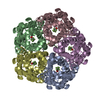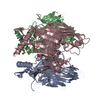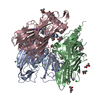+ Open data
Open data
- Basic information
Basic information
| Entry | Database: EMDB / ID: EMD-30952 | |||||||||
|---|---|---|---|---|---|---|---|---|---|---|
| Title | Structure of PfFNT in apo state | |||||||||
 Map data Map data | ||||||||||
 Sample Sample |
| |||||||||
 Keywords Keywords | Lactate / transporter / TRANSPORT PROTEIN | |||||||||
| Function / homology |  Function and homology information Function and homology informationhigh-affinity secondary active nitrite transmembrane transporter activity / lactate transmembrane transport / nitrite transport / lactate:proton symporter activity / vacuolar membrane / plasma membrane Similarity search - Function | |||||||||
| Biological species |  | |||||||||
| Method | single particle reconstruction / cryo EM / Resolution: 2.29 Å | |||||||||
 Authors Authors | Yan CY / Jiang X / Peng X / Wang N / Zhu A / Xu H / Li J | |||||||||
 Citation Citation |  Journal: PLoS Biol / Year: 2021 Journal: PLoS Biol / Year: 2021Title: Structural characterization of the Plasmodium falciparum lactate transporter PfFNT alone and in complex with antimalarial compound MMV007839 reveals its inhibition mechanism. Authors: Xi Peng / Nan Wang / Angqi Zhu / Hanwen Xu / Jialu Li / Yanxia Zhou / Chen Wang / Qingjie Xiao / Li Guo / Fei Liu / Zhi-Jun Jia / Huaichuan Duan / Jianping Hu / Weidan Yuan / Jia Geng / ...Authors: Xi Peng / Nan Wang / Angqi Zhu / Hanwen Xu / Jialu Li / Yanxia Zhou / Chen Wang / Qingjie Xiao / Li Guo / Fei Liu / Zhi-Jun Jia / Huaichuan Duan / Jianping Hu / Weidan Yuan / Jia Geng / Chuangye Yan / Xin Jiang / Dong Deng /   Abstract: Plasmodium falciparum, the deadliest causal agent of malaria, caused more than half of the 229 million malaria cases worldwide in 2019. The emergence and spreading of frontline drug-resistant ...Plasmodium falciparum, the deadliest causal agent of malaria, caused more than half of the 229 million malaria cases worldwide in 2019. The emergence and spreading of frontline drug-resistant Plasmodium strains are challenging to overcome in the battle against malaria and raise urgent demands for novel antimalarial agents. The P. falciparum formate-nitrite transporter (PfFNT) is a potential drug target due to its housekeeping role in lactate efflux during the intraerythrocytic stage. Targeting PfFNT, MMV007839 was identified as a lead compound that kills parasites at submicromolar concentrations. Here, we present 2 cryogenic-electron microscopy (cryo-EM) structures of PfFNT, one with the protein in its apo form and one with it in complex with MMV007839, both at 2.3 Å resolution. Benefiting from the high-resolution structures, our study provides the molecular basis for both the lactate transport of PfFNT and the inhibition mechanism of MMV007839, which facilitates further antimalarial drug design. | |||||||||
| History |
|
- Structure visualization
Structure visualization
| Movie |
 Movie viewer Movie viewer |
|---|---|
| Structure viewer | EM map:  SurfView SurfView Molmil Molmil Jmol/JSmol Jmol/JSmol |
| Supplemental images |
- Downloads & links
Downloads & links
-EMDB archive
| Map data |  emd_30952.map.gz emd_30952.map.gz | 167.6 MB |  EMDB map data format EMDB map data format | |
|---|---|---|---|---|
| Header (meta data) |  emd-30952-v30.xml emd-30952-v30.xml emd-30952.xml emd-30952.xml | 9.9 KB 9.9 KB | Display Display |  EMDB header EMDB header |
| Images |  emd_30952.png emd_30952.png | 64.4 KB | ||
| Filedesc metadata |  emd-30952.cif.gz emd-30952.cif.gz | 5 KB | ||
| Archive directory |  http://ftp.pdbj.org/pub/emdb/structures/EMD-30952 http://ftp.pdbj.org/pub/emdb/structures/EMD-30952 ftp://ftp.pdbj.org/pub/emdb/structures/EMD-30952 ftp://ftp.pdbj.org/pub/emdb/structures/EMD-30952 | HTTPS FTP |
-Related structure data
| Related structure data |  7e26MC  7e27C M: atomic model generated by this map C: citing same article ( |
|---|---|
| Similar structure data |
- Links
Links
| EMDB pages |  EMDB (EBI/PDBe) / EMDB (EBI/PDBe) /  EMDataResource EMDataResource |
|---|---|
| Related items in Molecule of the Month |
- Map
Map
| File |  Download / File: emd_30952.map.gz / Format: CCP4 / Size: 178 MB / Type: IMAGE STORED AS FLOATING POINT NUMBER (4 BYTES) Download / File: emd_30952.map.gz / Format: CCP4 / Size: 178 MB / Type: IMAGE STORED AS FLOATING POINT NUMBER (4 BYTES) | ||||||||||||||||||||||||||||||||||||||||||||||||||||||||||||||||||||
|---|---|---|---|---|---|---|---|---|---|---|---|---|---|---|---|---|---|---|---|---|---|---|---|---|---|---|---|---|---|---|---|---|---|---|---|---|---|---|---|---|---|---|---|---|---|---|---|---|---|---|---|---|---|---|---|---|---|---|---|---|---|---|---|---|---|---|---|---|---|
| Projections & slices | Image control
Images are generated by Spider. | ||||||||||||||||||||||||||||||||||||||||||||||||||||||||||||||||||||
| Voxel size | X=Y=Z: 0.6746 Å | ||||||||||||||||||||||||||||||||||||||||||||||||||||||||||||||||||||
| Density |
| ||||||||||||||||||||||||||||||||||||||||||||||||||||||||||||||||||||
| Symmetry | Space group: 1 | ||||||||||||||||||||||||||||||||||||||||||||||||||||||||||||||||||||
| Details | EMDB XML:
CCP4 map header:
| ||||||||||||||||||||||||||||||||||||||||||||||||||||||||||||||||||||
-Supplemental data
- Sample components
Sample components
-Entire : Pentameric complex of FNT
| Entire | Name: Pentameric complex of FNT |
|---|---|
| Components |
|
-Supramolecule #1: Pentameric complex of FNT
| Supramolecule | Name: Pentameric complex of FNT / type: complex / ID: 1 / Parent: 0 / Macromolecule list: #1 |
|---|---|
| Source (natural) | Organism:  |
| Molecular weight | Theoretical: 170 KDa |
-Macromolecule #1: Formate-nitrite transporter
| Macromolecule | Name: Formate-nitrite transporter / type: protein_or_peptide / ID: 1 / Number of copies: 5 / Enantiomer: LEVO |
|---|---|
| Source (natural) | Organism:  |
| Molecular weight | Theoretical: 34.492281 KDa |
| Recombinant expression | Organism:  |
| Sequence | String: MPPNNSKYVL DPVSIKSVCG GEESYIRCVE YGKKKAHYSN LNLLAKAILA GMFVGLCAHA SGIAGGLFYY HKLREIVGAS MSVFVYGFT FPIAFMCIIC TGSDLFTGNT LAVTMALYEK KVKLLDYLRV MTISLFGNYV GAVSFAFFVS YLSGAFTNVH A VEKNHFFQ ...String: MPPNNSKYVL DPVSIKSVCG GEESYIRCVE YGKKKAHYSN LNLLAKAILA GMFVGLCAHA SGIAGGLFYY HKLREIVGAS MSVFVYGFT FPIAFMCIIC TGSDLFTGNT LAVTMALYEK KVKLLDYLRV MTISLFGNYV GAVSFAFFVS YLSGAFTNVH A VEKNHFFQ FLNDIAEKKV HHTFVECVSL AVGCNIFVCL AVYFVLTLKD GAGYVFSVFF AVYAFAIAGY EHIIANIYTL NI ALMVNTK ITVYQAYIKN LLPTLLGNYI AGAIVLGLPL YFIYKEHYYN FERSKRDNND AQMKSLSIEL RN UniProtKB: Formate-nitrite transporter |
-Macromolecule #2: water
| Macromolecule | Name: water / type: ligand / ID: 2 / Number of copies: 80 / Formula: HOH |
|---|---|
| Molecular weight | Theoretical: 18.015 Da |
| Chemical component information |  ChemComp-HOH: |
-Experimental details
-Structure determination
| Method | cryo EM |
|---|---|
 Processing Processing | single particle reconstruction |
| Aggregation state | particle |
- Sample preparation
Sample preparation
| Buffer | pH: 8 |
|---|---|
| Vitrification | Cryogen name: ETHANE |
- Electron microscopy
Electron microscopy
| Microscope | FEI TITAN KRIOS |
|---|---|
| Image recording | Film or detector model: GATAN K3 (6k x 4k) / Average electron dose: 50.0 e/Å2 |
| Electron beam | Acceleration voltage: 300 kV / Electron source:  FIELD EMISSION GUN FIELD EMISSION GUN |
| Electron optics | Illumination mode: FLOOD BEAM / Imaging mode: BRIGHT FIELD |
| Experimental equipment |  Model: Titan Krios / Image courtesy: FEI Company |
- Image processing
Image processing
| Startup model | Type of model: NONE |
|---|---|
| Final reconstruction | Resolution.type: BY AUTHOR / Resolution: 2.29 Å / Resolution method: FSC 0.143 CUT-OFF / Number images used: 221350 |
| Initial angle assignment | Type: ANGULAR RECONSTITUTION |
| Final angle assignment | Type: ANGULAR RECONSTITUTION |
 Movie
Movie Controller
Controller













 Z (Sec.)
Z (Sec.) Y (Row.)
Y (Row.) X (Col.)
X (Col.)





















